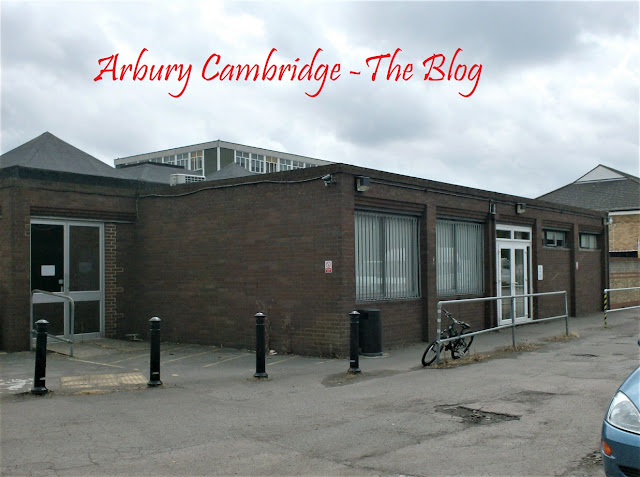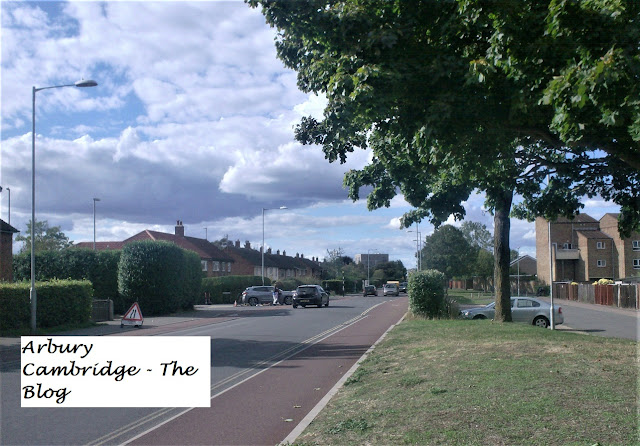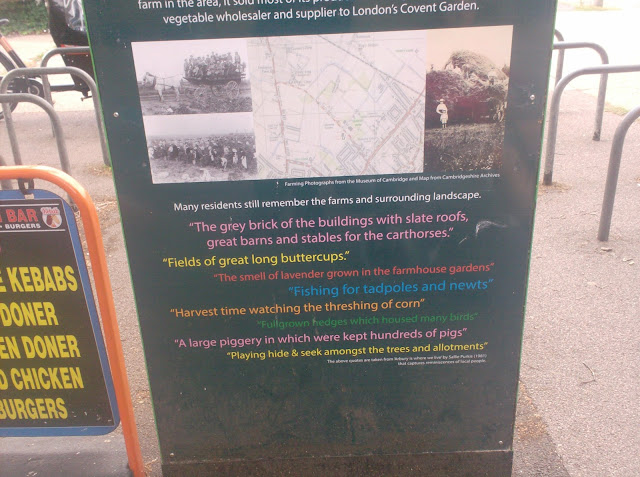Debs and Andy, intrepid Arbury Archivists, set off for an Arbury day out on 16 September, 2022. Here's Debs in Arbury Town Park, Campkin Road, admiring the view of Colonel Bennett's Manor Farmhouse garden trees across the road.
Campkin Road. The site across the road once contained the Manor Farmhouse and the view was then more like the picture below. A tree by the front of the farmhouse had been earmarked for saving at the time of the North Arbury development in 1960, but sadly died. The small island at the top of the alley leading to the garages marks the spot.
Looking across part of the old Arbury Meadows, now containing Nicholson Way, Hanson Court, Walker Court and much more. Andy was thrilled to use the Arbury exploration to demonstrate his tremendous skill as a lousy photographer.
Much of the area of North Arbury and Arbury/Orchard Park was once known as the Arbury/Harborough Meadows, furlongs and corner. King's Hedges had nothing to do with it until the council planners' King's Hedges Estate sub-district in North Arbury and the huge King's Hedges road redirection and expansion for the A14 in the 1970s, which lopped off the end of the original Arbury Road and brought the new King's Hedges Road across the historic Arbury area, right by the ancient earthwork at Arbury Camp. The power of the infernal combustion engine! This map shows the area after the formations of the Manor, Arbury Camp and Hall Farms, which followed the Chesterton Enclosures of 1840.
The Arbury Community had been campaigning for a community centre since the early-to-mid 1960s. Finally, in 1974, it happened. The Arbury Community Centre is now one of the main hubs of the original Arbury Estate.
In the Manor Farm's old Park Meadow, by North Cambridge Academy, we found the sad concrete remains of the old Manor School 'New Block', built in the early 1970s. This was the home of the fourth and fifth years' 'break time' areas, the photography darkroom, the dining hall (the original dining hall became the main corridor in the 1950s complex), the human biology lab, and much else. On leaving, we met two pupils from North Cambridge Academy who were very interested in Arbury history, very polite and a credit to themselves and the school.
The old 'New Block' at the Manor Community College, with a glimpse of the boys' gym and the school's highly distinctive tower block in the background.
Nicholson Way, viewed across Arbury Town Park, home to the beloved Arbury Carnival since 1977.
Another view of the Arbury Community Centre, taken with the unique lack of skill only Andy can bring to photography.
Campkin Road - looking towards Arbury Road. The old cottage, once No 3 Manor Farm Cottages, built in the 1920s can be seen on the left.
Back in 1983, Mr Gordon Cardinal, who wrote 'THE ARBURY', his contribution to the Arbury Archive (featured on this blog), told us to have a look in the hedgerow near Nicholson Way, where we would find the foundations to the old Manor Nurseries entrance columns. We did look - and we did find them. Andy and Debs decided to repeat the exercise this year and perhaps get a photograph of them, but the pavement had become a cycleway and was no place for an overweight gent in a 'Magic Roundabout' T-shirt or a lady in a wheelchair. Never mind.
Ernest Sale's Manor Nurseries on Arbury Road were well known throughout Cambridge. He lived at No 1 Manor Farm Cottages, which is now the site of the roadway in Campkin Road, near the Arbury Road junction.
Andy has always been delighted that an 'Arbury Is Where We Live!' quote is featured from his grandmother's cousin, Reg Jones, who lived in Leys Avenue, on the Arbury Court Arbury history display. The piggery referred to in the quote belonged to Andy's great-great grandfather, Richard Brett, at Manor Farm. Richard will be the subject of our next 'Arbury People' profile.
Richard Brett of the Manor Farm on Arbury Road did many jobs to keep his family of eleven fed and clothed: he was Manor Farm horse keeper, horse keeper at the Milton Road Sewage Farm, farm labourer, pig and goat breeder, smallholder and more - very often holding down several jobs at once.
The Cambridge Gurdwara in Arbury Court is Cambridgeshire's first Sikh temple, and was once the Snowcat public house, built in 1959 to 'serve the rapidly expanding Arbury Estate.' The building cost £16,000!
We'll take a break here. Sadly, we didn't penetrate that far into North Arbury - we wanted to take a look at The Ship, the North Arbury Chapel and the legendary Arbury Kebab, but we did go on into South Arbury as far as the boundary of the original Arbury Estate at the Carlton Way/Gilbert Road junction. Part two is here.









.JPG)











Comments
Post a Comment